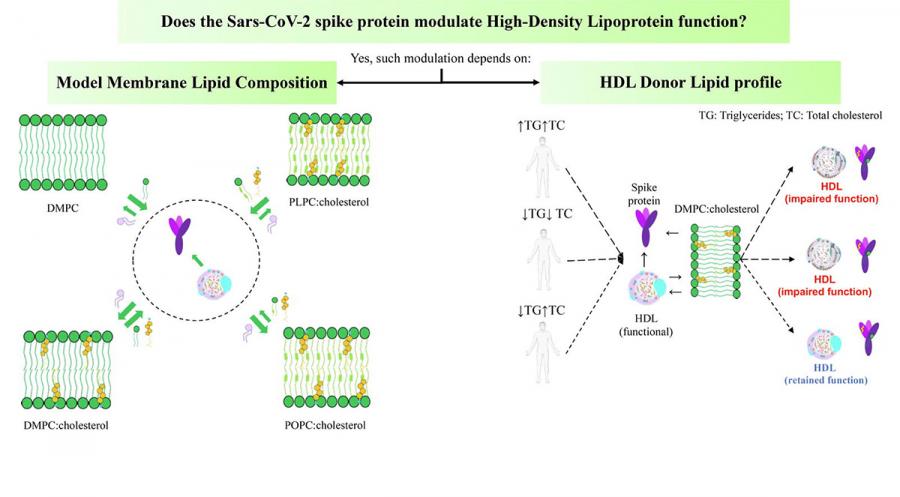Key Points
International investigators have found a connection between the plasma lipid profile of a person and the severity of COVID-19 disease
The interaction between the S protein and the high-density lipoprotein (HDL) might also contribute to the adverse effects observed in some individuals following mRNA COVID-19 vaccination
Deuterated lipids supplied by the National Deuteration Facilty were used to understand the effect of lipid saturation on the ability of S protein to high jack lipid metabolism during infection
The National Deuteration Facility (NDF) at ANSTO continues to support biomedical research on COVID-19 by providing bespoke deuterated lipids for studies of the structure of the virus and its complex molecular interactions.
In the latest research published in the Journal of Colloid and Interface Science, a large collaboration of European investigators led by Prof Marité Cárdenas of Malmö University, gained insights into how the SARS-CoV-2 spike protein (S protein) impacts with lipid metabolism in the body with implications for COVID-19 infection and mRNA vaccination.
Although the mechanism of the interactions remains unclear, the investigators found a connection between the plasma lipid profile of a person and the severity of COVID-19 disease.
The interaction between the S protein and the high-density lipoprotein (HDL) might also contribute to the adverse effects observed in some individuals following mRNA COVID-19 vaccination.
"Deuterated lipids with unsaturated and polyunsaturated fatty acid alkyl chains, that were supplied by us and not available elsewhere , were used in this study to understand the effect of lipid saturation on the ability of S protein to high jack lipid metabolism during infection," explained co-author Dr Tamim Darwish, Leader, NDF.
"The deuteration of the biological materials, in which hydrogen is replaced by deuterium, was essential for the neutron reflectometry as well as the infrared spectroscopy measurements of a model membrane," he said.

Following earlier discussions with the research group, a process for deuterating the linoleic acid based-lipid, PLPC, was developed by Dr Michael Moir and colleagues at the NDF. The research was published in a paper in Advanced Synthesis and Catharsis in 2022 and was featured on the cover of the journal.
"Deuterated linoleic acid and its associated phospholipid can be isolated from biological systems but only in very small amounts. We were able to synthesise sufficient quantities of these molecules for the study," said co-author Dr Moir.
This omega-6 fatty acid is one of two essential polyunsaturated fatty acids. It had been shown previously that the polyunsaturated fatty acid binds to the novel coronavirus SARS-CoV-2 and effectively interferes with binding to a key receptor.
Previous studies had shown that the S protein can remove lipids from model membranes and interfere with lipid removal and exchange processes carried out by HDL.
The latest results suggested that the S protein from the SARS-CoV-2 virus has a stronger ability to remove cholesterol and polyunsaturated lipids compared to saturated and monounsaturated lipids.
The neutron reflectometry experiments in the recent research conducted at ANSTO's Australian Centre for Neutron Scattering on the Spatz instrument and ILL in France, revealed the integrity and composition of lipid bilayers when exposed to the S protein and/or HDL.
"The team wanted to know what type of lipids from the HDL can be extracted and depleted by the S protein, thus changing its surface properties and function," explained Dr Darwish.
The study showed that the S protein changes HDL function in a manner that depends on the lipid serum profile of a person.
The results indicated that individuals with low triglycerides and high cholesterol serum levels profile should have a lower tendency to have their lipid metabolism high jacked by the SARS-CoV-2 virus and could present a weaker interaction with the S protein upon COVID-19 illness or vaccination against COVID-19.
The research suggested the S protein may bind to the high-density lipoprotein (HDL), potentially interfering with its normal function.
The S protein, which is present on the virus surface, may use the same interaction pathway that HDL uses to interact with specific cell membrane receptors.
This interaction between the S protein and HDL may contribute to the adverse effects observed in some individuals following mRNA COVID-19 vaccination.
exhibit a weaker interaction with the S protein during COVID-19 illness or vaccination.
The team used various experimental techniques at multiple institutions.
Other ANSTO scientists who contributed to the research included Dr Robert Russell, Dr Nageshwar Rao Yepuri and Dr Anton Le Brun.
https://www.sciencedirect.com/science/article/pii/S0021979723007361






